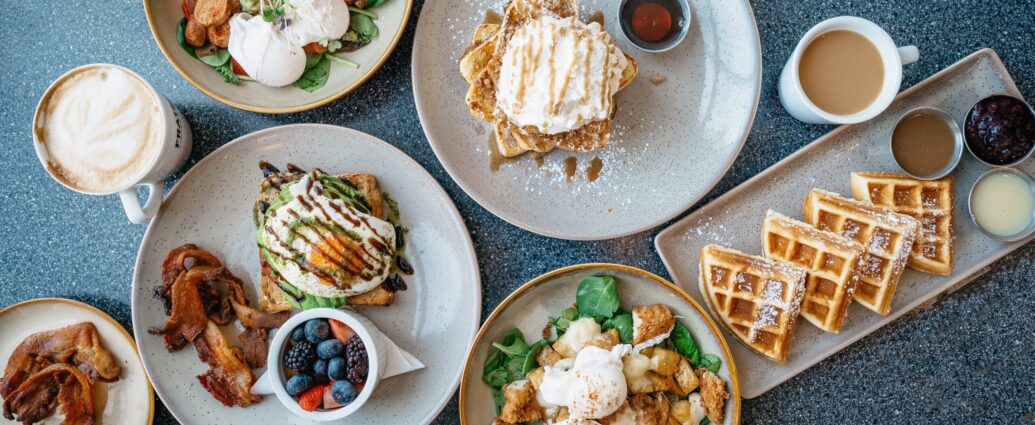Cara-Louise Scott
Brunch is a meal that more and more people are becoming accustomed to. Some restaurants specialise in serving it and influencers love to post photos of the hottest plates on social media. But where did it come from? And why is it so popular?
What Is Brunch?
For me, brunch is breakfast and lunch melded into one medium-large meal. For some, it is a meal you have in the late morning or as a substitute for lunch (when you skip breakfast or wake up ‘too late’ for it). And, for others, it’s an excuse to go out drinking late morning with their girlfriends. Technically, brunch is all of these things.
By definition, brunch is a meal eaten in the late morning that is a combination of breakfast and lunch. Typically, it’s eaten late in the morning because it combines elements of breakfast and lunch items. It’s usually heartier than your average meal so you don’t have to separate it into two.
@healthyfitbella You need to add these to your menu this week, such a handy breakfast idea 🍳 #bagel #bagels #cheesybagels #eggybagel #brunch #breakfast
But Where Did This Idea Come From?
In 1895, Hunter’s Weekly published an article advocating for “a late social breakfast on Sunday”, which would “make life brighter for Saturday night carousers.” The writer also suggested that alcoholic drinks be served (so you may want to thank him for the development of bottomless brunch).
In 1920, brunch made its way across America as high-end hotels added it to their menus. In the 1930s, it slowly filtered down to the middle class. Brunch spread across social settings and restaurants in the 1900s, primarily being a way to sell leftovers from the night before. By 2000, chef and food writer Anthony Bourdain was warning people against brunch, due to it being rehashed old food.
The Revival Of Brunch
In the millennium, brunch blossomed into a global concept, helped by the rising popularity of Chinese dim sum. Originating in Cantonese cuisine, dim sum is a large range of small dishes eaten for brunch. This can be served as early as five in the morning. The most common dishes include dumplings, steamed buns and chicken feet.
Today, brunch is incredibly popular in restaurants and cafes, especially at the weekend. Searches for the meal have more than doubled in the last twenty years. In particular, searches for bottomless brunch have increased by over 100 percent.
But why is this amalgamation so popular? Why not ‘linner’ or ‘dunch’?
Well, brunch offers a broad choice selection of food for everyone. Whether you want sweet pancakes or a savoury fry-up, this meal encompasses every kind of taste palate and often includes several different cuisines.
“It is a money-making machine”
For restaurants and pubs, having an additional menu isn’t a problem. It means they can extend their typical ‘breakfast’ timings and offer food until later in the day, encouraging customers to visit at less busy times. Businesses can gain more money, by opening early and serving the cure to Friday or Saturday’s hangover.
The Role Of ‘Foodie Culture’
There has been a rise in ‘foodie culture’ on social media in recent years. Foodies equate food with art, in the sense they enjoy cooking, eating, reading, and talking about food. Photographing and filming their food to post online is also central to foodie culture. And typically, most foodies are obsessed with brunch.
Any time you sit in a restaurant you are likely to see people taking photos of their food the second it arrives. We have become obsessed with documenting our food and wanting it to look aesthetic, and taste good. There is a huge market for brunch. It is a money-making machine, with some restaurants operating on brunch menus alone and influencers earning money from their foodie posts.
Influencers and food haunts feed (pun intended) each other’s businesses. By attracting influencers (through experimental dishes or sponsorships), restaurants can be promoted to thousands of followers. In turn, by posting extravagant meals and fashionable brunch locations, influencers can keep up a constant stream of content and, as a result, their income. This cycle has contributed to the popularity of brunch in foodie spaces online.
@bookthistrip must try brunch spot in london #nobubrunch #nobubrunchlondon #londoneats #londonthingstodo
Bottomless Brunch
But the aspect of brunch that people enjoy the most is socialising. This is where bottomless brunch comes in: groups of friends, family, or colleagues meet at a restaurant to eat and drink as much as they want. Bottomless brunch is a fantastic way to have fun, enjoy good food, and save money on drinks. It is particularly popular for hen do’s and birthdays.
Today, a huge range of London restaurants are offering bottomless brunches, inspired by Manhattan’s trend. It’s the preferred weekend meal for the majority of Londoners.
Many publications have shared their favourite spots, showcasing a wide selection of places to eat. Even with the cost of living crisis, recent data from the Global Web Index indicates that Brits are not sacrificing going out to eat. In fact, the UK is the least worried (21.8 percent) about spending money on going out to bars, restaurants, and cinemas. This is comparable to France (43.6 percent), Germany (27.1 percent) and Italy (49.9 percent).
Forget going out to lunch or dinner. Without a doubt, brunch is one of the trends that is here for the long run.
READ NEXT:
-
A HISTORY OF THE SANDWICH: BRITAIN’S FAVOURITE FOOD
-
IS COOKTOK KILLING THE NEED FOR COOKBOOKS?
-
WHAT IS THE FUTURE OF THE MEAT INDUSTRY?
Featured image courtesy of Davey Gravy on Unsplash. No changes made to this image. Image license can be found here.

